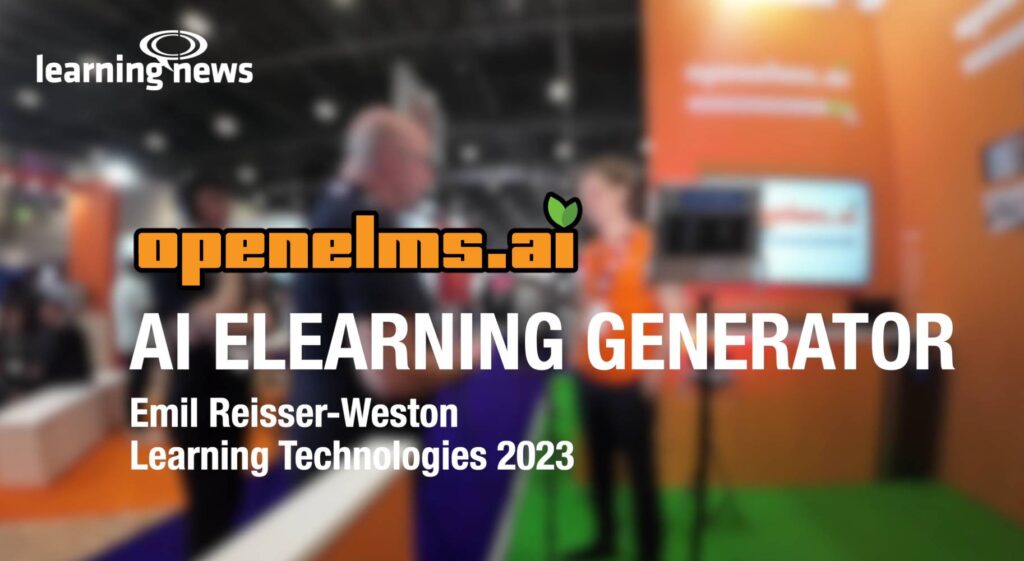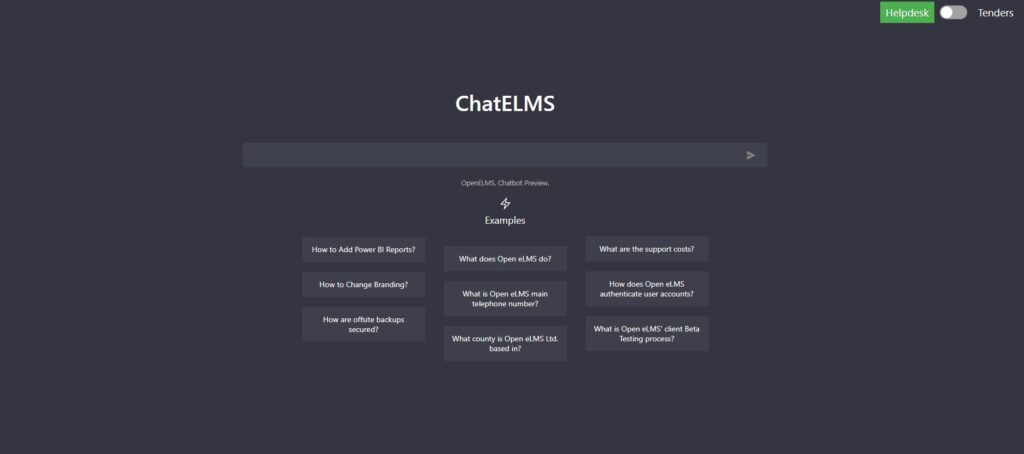How to Use AI in eLearning: Enhancing Business Training Strategies

In the rapidly evolving landscape of online education, Artificial Intelligence (AI) has emerged as a pivotal force, revolutionising the eLearning experience. Through its ability to adapt content to meet diverse student needs and preferences, this transformative technology has created unprecedented opportunities for personalised learning. By harnessing AI, educators and institutions can craft dynamic and engaging learning environments, fostering deeper understanding and retention. This article explores the integration of AI in eLearning seen in tools such as Open eLMS AI, highlighting its impact on personalised learning experiences, course material adaptation, and the overall learning process. Join us as we explore how AI is reshaping the future of education, making learning more accessible, efficient, and tailored to individual learners. Key Takeaways Core Mechanisms of AI in Enhancing eLearning To fully understand the role of AI in eLearning, let’s explore the core AI mechanisms that are instrumental in enhancing digital learning experiences. Learning Management Systems (LMSs) manage eLearning delivery, AI leverages machine learning algorithms to personalise learning paths, aligning them uniquely to each learner’s pace and proficiency. Natural language processing empowers AI to develop interactive chatbots, providing instantaneous aid and guidance to learners. AI also facilitates adaptive learning by adjusting the complexity and delivery of content in real-time, based on each learner’s proficiency and pace. As a result, AI not only personalises eLearning but also makes it more dynamic, interactive, and learner-friendly. Such core mechanisms of AI have revolutionised eLearning, making it more effective and engaging. Advanced Applications of AI in eLearning Now, let’s turn our attention to the advanced applications of AI in eLearning. This includes predictive analytics for both learning objectives gaining learner insights, the use of Natural Language Processing (NLP), and the implementation of gamification and adaptive assessments. These innovative approaches are revolutionising the way we conduct business training and offer untapped potential for enhancing learning outcomes. Predictive Analytics and Learner Insights In the realm of eLearning, we’re leveraging predictive analytics and data mining to decipher learner behaviours and forecast future performance, paving the way for targeted interventions. This advanced application of AI allows us to: Natural Language Processing (NLP) Although predictive analytics already help us forecast learner performance and engagement, another potent tool in the AI arsenal is Natural Language Processing (NLP). NLP revolutionises interactivity and engagement in eLearning through chatbots and virtual assistants. Capable of understanding and responding to human language, these AI-driven tools can facilitate interactive learning environments, creating more engaging experiences for learners. NLP allows chatbots to instantly answer queries by offering explanations or directing learners to relevant resources. Similarly, virtual assistants can provide personalised support, enhancing learner engagement and comprehension. These advanced applications of NLP for eLearning not only make learning more interactive but also adapt to the learner’s pace and style, paving the way for a truly personalised learning experience. Gamification and Adaptive Assessments Diving deeper into the realm of AI in eLearning, we find that gamification techniques and adaptive assessments play a pivotal role in sparking learner motivation and tailoring evaluations based on individual performance. AI-powered gamification makes learning interactive, fun, and engaging. Adaptive assessments, on the other hand, accommodate each learner’s unique pace, knowledge, and skills. The Impact of AI on eLearning Development and Delivery Let’s now turn our focus to the transformative impact of AI on eLearning development and delivery. Streamlining Course Development In the realm of eLearning development and delivery, AI tools are revolutionising the process by swiftly generating course outlines, texts, images, and even video content. This significantly reduces the time and resources typically required. Here’s how these AI authoring tools, such as the free-to-try Open eLMS AI, have dramatically simplified content creation and course development: We’re finding that eLearning created by AI isn’t just for the future; it’s here and now. Enhancing Learner Engagement and Retention While AI is streamlining course development, it also plays a pivotal role in enhancing learner engagement and retention. It tailors the learning experience to individual students, making it more relevant and effective. Through interactive simulations, AI creates a highly engaging environment that not only captivates learners but also aids with information retention. These simulations provide learners with hands-on experiences, allowing them to apply knowledge in a risk-free setting. They’re exciting and challenging, and closely mirror real-world scenarios to foster learners’ deep connection with the content. Moreover, AI offers insights into each learner’s progress and struggles, enabling us to provide personalised support. AI is transforming eLearning, making it more engaging, personalised, and effective. Course Programme Creations While AI is streamlining eLearning development, it can also design and populate entire programmes of learning. Learning Management Systems such as Open eLMS can create these programmes using AI with criteria of skills, knowledge and behaviours automatically created and populated with learning resources from a library. AI is embedded into this process so course curation and creation are seamlessly managed using the technology. Accessibility and Inclusion AI significantly enhances eLearning’s accessibility and inclusion features by breaking down language barriers. It enables the automatic translation of text and voiceovers to cater to a global audience. Thanks to AI’s power, we’re witnessing a transformation that’s making eLearning more inclusive and accessible than ever before. Here’s how AI is revolutionising the language barriers of eLearning: AI is therefore key in breaking down walls and fostering a more inclusive, accessible learning environment for all. Benefits of Integrating AI into eLearning Strategies Integrating AI into eLearning strategies has numerous benefits that we can’t overlook. We’ve established that it offers personalised learning experiences, makes the most efficient use of resources, and gives us data-driven insights for continuous improvement. Let’s now expand upon these points to ascertain the full potential of AI in eLearning. Customised Learning Experiences How can AI revolutionise eLearning by providing customised learning experiences? By tailoring learning materials to individual learner needs, Open eLMS AI enhances learning to create truly personalised learning experiences. This facilitates a more engaged, productive learning environment, resulting in improved comprehension and retention of educational content. AI makes this possible by: Efficient Resource Utilisation Building
Open eLMS MD Interview on Generative AI tool openelms.ai

Our Managing Director, Emil Reisser-Weston, was interviewed recently by Learning News regarding it’s AI powered elearning authoring system: openelms.ai. In this interview Emil explains how AI is used to automatically generate a script, organize learning objectives, and divide them into different sections within the course. It also generates visuals, videos, and animations, mimicking the process used by human designers who apply design heuristics. Despite sounding unbelievable, the tool has proven to be effective. To gain a comprehensive understanding of this innovative tool, watch the video where Emil Reisser-Weston explains its features and functionality, then visit www.openelms.ai and try it out.
Benefits of creating your own AI engine

Why do I need a custom AI? Open eLMS Chat is a powerful chatbot platform designed to transform your company’s communication dynamics. Powered by a state-of-the-art chat engine, the Open eLMS Chat mirrors the capabilities of Chat GPT4 but is tailored uniquely for your business. The heart of Open eLMS Chat lies in its bespoke admin interface, an elegantly designed system that blends simplicity with powerful features. Not only is it user-friendly, but it also requires no coding skills to customize your chatbot to your brand’s personality, information needs, and preferred interaction styles. Implement your own chatbot This advanced solution allows you to create custom GPT chatbots, trained exclusively on your company’s data, guaranteeing the most personalized responses for your employees and customers. The chatbots can be embedded anywhere within your digital ecosystem, either as a customer-facing tool or an internal communication facilitator. Security is guaranteed The platform provides the option of a Dedicated Server, enhancing privacy and security by hosting your sensitive data in separate repositories. This feature ensures your data stays protected while your chatbot learns and improves from past interactions. Create custom e-learning using your AI When paired with openelms.ai, the synergy is game-changing. Open eLMS AI simplifies and elevates eLearning course creation, turning user-specified topics or existing materials into engaging, interactive eLearning experiences. Meanwhile, Open eLMS Chat serves as a dynamic knowledge hub, allowing organizations to upload, centralize, and manage their knowledge base on dedicated servers. This duo revolutionizes eLearning and communication experiences in organizations, regardless of their size or industry. From small businesses to large enterprises, the Open eLMS Chat is a perfect fit for everyone. Let’s embark on this journey to create a chatbot that is truly a reflection of your brand and meets your unique needs! Key Features Data-Specific Chatbots: Train chatbots on your unique company data, ensuring they provide the most personalized and relevant responses. File Upload Flexibility: Have a wealth of resources at your disposal. Open eLMS Chat supports the upload of various file types, including MP4s, PDFs, PowerPoints, and more. This makes it easy to share resources and information with your chatbot. Ecosystem Integration: Seamlessly embed Chat eLMS into your existing digital ecosystem, providing real-time, interactive communication internally or with your customers. User-Friendly Interface: Our platform is designed to be easily navigable, making it user-friendly even for those without coding skills. Customizing your chatbot becomes an intuitive and effortless process. Optional Dedicated Server: For enhanced privacy and security, opt for a Dedicated Server to host your sensitive data. This ensures your data remains protected while your chatbot continuously learns and improves. Open eLMS AI Integration: Combine Chat eLMS with openelms.ai to create an unparalleled eLearning experience. Use openelms.ai for intuitive course creation and Open eLMS Chat to centralize and manage your knowledge base. With Open eLMS Chat, you’re not just getting a chatbot; you’re investing in a comprehensive communication solution that represents your brand and meets your organization’s unique needs
The advantages of AI for elearning creation

Introduction Artificial Intelligence (AI) has been rapidly transforming various industries, and eLearning is no exception. With AI-powered tools, elearning content creation has become faster, easier, and more personalized than ever before. In this article, we will explore the benefits of AI in eLearning content creation and how it can improve the learning experience for students. Personalized Learning One of the most significant benefits of AI in eLearning content creation is personalized learning. With AI-powered tools, educators can create personalized content based on a student’s learning style, preferences, and performance data. This allows students to learn at their own pace and level, improving their engagement and overall learning outcomes. Personalized learning also helps educators identify knowledge gaps and provide targeted interventions to improve student understanding. Increased Efficiency AI-powered eLearning content creation is more efficient than traditional methods. It can create content quickly, accurately, and consistently, allowing educators to focus on other aspects of their job, such as teaching and engaging with students. This efficiency saves time and reduces costs, making eLearning more accessible to a broader audience. Elearning can be created in seconds using openelms.ai Enhanced Engagement AI-powered eLearning content creation can significantly enhance student engagement. With interactive content, such as videos and simulations, students are more likely to retain information and engage with the material. AI-powered content can also adapt to a student’s performance, providing feedback and adjusting the difficulty level of the content accordingly. This personalized approach can improve student motivation and interest in learning. Improved Accessibility AI-powered eLearning content creation can improve accessibility for students with disabilities. For example, text-to-speech technology can convert written content into audio format, making it accessible to students with visual impairments. This technology can also benefit students with dyslexia or other learning disabilities, providing them with alternative ways to learn and engage with the material. All openelms.ai courses include voiceovers and video presenters in up to 27 different languages Consistent Quality AI-powered eLearning content creation provides consistent quality across all content, regardless of the amount produced. The use of AI-powered tools ensures that content is created in a standardized format and is free of human error, ensuring high quality and accuracy. This consistency is essential in eLearning, where learners expect high-quality content that is easy to understand and learn from. AI elearning creation tool – openelms.ai – produces elearning of consistent quality Cost Savings AI-powered eLearning content creation can be cost-effective for educational institutions. The use of AI-powered tools reduces the need for human labor, saving time and costs associated with traditional content creation methods. Additionally, AI can generate content at a faster pace than humans, enabling educators to create more content in less time. Conclusion AI-powered eLearning content creation has numerous benefits, including personalized learning, increased efficiency, enhanced engagement, improved accessibility, consistent quality, and cost savings. With AI-powered tools, educators can create engaging and effective eLearning content that meets the needs of individual learners, providing an optimal learning experience. As AI technology continues to evolve, we can expect to see even more innovative solutions for eLearning content creation.
5 AI systems to revolutionise EdTech

AI has taken a lot of media attention of late. What I’d like to do in this article is to cut through the hype and show you 5 products which will dramatically affect your approach to EdTech in the coming months. These products (or similar ones) will be invaluable to you whether you are a manager, content creator or consumer of edTech content. We will then examine where this fast-moving field is heading and what exciting and truly remarkable developments you can expect in the near future. Chat GPT Chat GPT – now serving as the flagship of AI – has been adopted at a rate never seen before in the history of the internet. To reach a million users, Netflix took 3.5 years, Twitter took 2 years, Facebook took 10 months, Spotify took 5 months, and Instagram took 2.5 months. Chat GPT took only five days to reach one million users. Only two months after its launch, it had 100 million active users. The best way to explain the success is to use it, visit https://chat.openai.com/chat and ask it to write you a Shakespearean sonnet, a pub quiz or summarise War and Peace in 200 words. If you have not done so, so it, take your jaw floor and then start to have a conversation with it. Ask it to change the sonnet to a song by Bob Dylan, make the pub quiz about the 1980s or ask for the book summary to be condensed to 50 words. The engine adapts and will bend to your wishes. It is not a search engine; its answers are generated from scratch each time rather than regurgitated from a website. So how can this apply to edTech? Ask Chat GPT to construct a curriculum, write a training script or a quiz on any given topic. The results may not always be quite what you are looking for, but they can be edited and are generally pretty good. Chat GPT does this by absorbing vast quantities of data from forums, posts and websites and it is constantly fine-tuned by human feedback. It also knows about learning styles and pedagogical models, selecting the best approach for the training material. It may not be perfect, but it’s getting close. You can of course find holes in the interpretation of facts, but the point is that AI engines such as this one are growing and training themselves all the time. They are getting better to the point that in 6 months’ time, the results we are seeing now will be primitive by comparison. The time to get used to working with an AI engine is no. I would also say that despite bad press, Google is coming back into this space with its engine Bard. They have been working a lot longer and buying up experts in this area for over 10 years now so I’d look into their offering with interest when it’s launched. Midjourney Midjourney is one of the most fun AI tools on the market at the moment. Midjourney is an image creation AI engine which has been trained on millions of images in a variety of styles and uses that knowledge to create images from scratch. Midjourney works through the Discord chat engine, simply add the Midjourney server and type an /imagine command, here you can see 4 examples it has given, these can be enlarged and utilised in elearning to create immersive environments in which you can place your training. There is no need for any design input, simply type in the description, desired aspect ratio etc and voila: an image is born! Midjourney has a gothic feel to it, if you don’t mind a bit of ‘drama’ in your images. If that’s not for you, then other image creation tools do exist (e.g. DALL-E from Open AI the people behind Chat GPT) but we have found Midjourney gives the most impressive results. Microsoft Power BI / Excel / Google Sheets It may surprise you to see these data analysis tools listed in an article about AI, but AI has been embedded in these systems for years. AI can be used to ask natural language questions about the data to get meaningful results. For instance, in Google Sheets hold down Shift + Ctrl + X and you will now see an Explore menu come up on the right-hand side of the screen. Use this to ask questions directly from the data; for example, what is the most popular category, or how many subcategories are there? It will also automatically create graphical views of the data. Learning Management Systems will increasingly move to adopt this method of analysis rather than putting the onus on the user to create data views and analyse reports. I believe you will see features like this in your LMS (as well as your connected Management Information Systems) very soon. Mykeyworder Mykeyworder is a handy tool for ‘reading’ images. The traditional view of image data is that the image itself is a blank slate; you would need a human to analyse the data and add a list of keywords to describe the image. AI – and specifically mykeyworder (www.mykeyworder.com/) – can automate this process. It has an easy-to-use API which can link to your application to bring meaning to your imagery. This will enable content curators to compile a list of imagery to be used for learning purposes and learners to search the same repository for appropriate content. D-id D-id (www.D-id.com) allows you to create video presenters from text or uploaded voice. Editors can upload the face of anyone and it will create a video character. The videos it creates are convincing, using lip synching technology with any pre-selected voice. The video can be downloaded and used in elearning or as stand-alone resources to add personalisation to learning content. Other Tools I have previewed my favourite AI tools, but there are plenty more which we are using on a daily basis to shape the Edtech systems and
